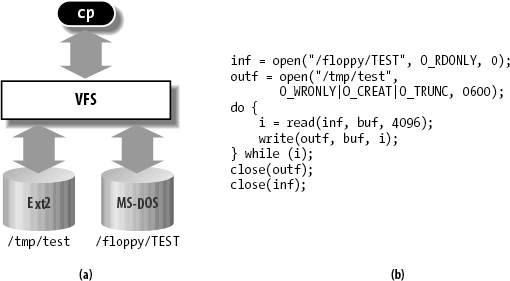The Role of the Virtual Filesystem (VFS)
The Virtual Filesystem (also known as Virtual Filesystem Switch or VFS) is a kernel software layer that handles all system calls related to a standard Unix filesystem. Its main strength is providing a common interface to several kinds of filesystems.
For instance, let’s assume that a user issues the shell command:
$ cp /floppy/TEST /tmp/test
where /floppy is the mount point of an MS-DOS diskette and /tmp is a normal Second Extended Filesystem (Ext2) directory. The VFS is an abstraction layer between the application program and the filesystem implementations (see Figure 12-1(a)). Therefore, the cp program is not required to know the filesystem types of /floppy/TEST and /tmp/test. Instead, cp interacts with the VFS by means of generic system calls known to anyone who has done Unix programming (see the section "File-Handling System Calls" in Chapter 1); the code executed by cp is shown in Figure 12-1(b).

Figure 12-1. VFS role in a simple file copy operation
Filesystems supported by the VFS may be grouped into three main classes:
- Disk-based filesystems
These manage memory space available in a local disk or in some other device that emulates a disk (such as a USB flash drive). Some of the well-known disk-based filesystems supported by the VFS are:
Filesystems for Linux such as the widely used Second Extended Filesystem (Ext2), the recent Third Extended ...
Get Understanding the Linux Kernel, 3rd Edition now with the O’Reilly learning platform.
O’Reilly members experience books, live events, courses curated by job role, and more from O’Reilly and nearly 200 top publishers.

